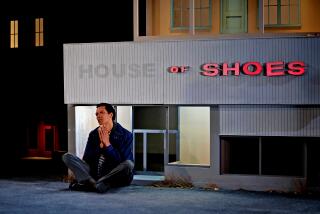STAGE REVIEW : The Audience Is the Ump for Yale Repâs âCobbâ
SAN DIEGO â âBaseball was a team game,â says one of the three Ty Cobbs in Lee Blessingâs âCobbâ at the Old Globe. âThat was its only flaw.â
You might say as much about theater, although to judge by this visiting Yale Repertory Theatre production, team effort is the lifesaver for Blessingâs play.
To clarify: âCobbâ is, and is not, a one-person show--or rather, a two-person show. (There is the goading and ubiquitous presence of Oscar Charleston snaking through Blessingâs play, and portrayed with gently ironic equanimity by a particularly fine Dan Martin.)
To clarify again: Since Cobb was the best, meanest, most bigoted, driven, competitive and hated baseball player of all time (âYou think baseball is your national pastime? It isnât; itâs mineâ), there is no one to share the play with him. Charleston excepted.
If you canât find too many people with whom to carry on a conversation, carry it on with yourself. âCobbâ becomes a series of exchanges among him, himself and he: Cobb as the eager young âGeorgia Peachâ (James E. Reynolds); Cobb as Ty, the cutting neo-Nazi middle-aged millionaire-in-the-making (George Gerdes), and Cobb as the faintly mellower Mr. Cobb (William Newman), the elder statesman who opts for that popular convenience of age: selective retrovision.
Conversation might be too generous a term for what goes on here. The three ages of this man may wrangle with one another, but they also do a lot of talking to the audience, which is dragged in as a silent umpire.
Itâs another way to find out about this ruthless baseball machine who was given the unlikely nickname âThe Georgia Peachâ at 18, just three weeks, as he tells us, after his mother killed his father.
Who is this paradoxical champ, whose outwardly successful life in baseball and business never quite added up, even if it did set a standard for all future game-playing on and off the diamond?
He was the first to earn an improbably high sports salary (an unprecedented $50,000 at the time), to endorse commercial products (including Coca-Cola, the ownership of whose stock made him a millionaire) and to be elected to baseballâs hall of fame, winning 222 votes of a possible 226.
Yet when Cobb died in 1961, only two ball players attended his funeral, and a hometown Cobb museum subsequently withered from lack of interest.
âItâs my instinct to dominate and destroy those around meâ confesses middle-aged Ty, after a failed marriage and the untimely death of two of his five sons. âI took a rustic game called baseball and applied the science of warfare to it.â So how do you drum up interest in an audience for a man with the warmth of a boa constrictor?
By counting on the fascinating paradox of hatefulness and excellence, batting a Cobbesque .367 with the clever repartee, and injecting the presence of the only man against whom Cobb never had a chance to try his mettle: Charleston, who played in the segregated Negro League but was known as the black Ty Cobb.
Charleston is largely there to nip at Cobbâs heels, scoring hits now and then, and providing the piece with whatever measure of tensile stress it develops, which is not much. âCobbâ is a dramatically placid play that trades off surprise for insight and well-placed zingers, sometimes attached to little-known fact. Weâre not asked to love the guy, just to contemplate a life curiously lived.
This considerably narrows the playâs scope. Like Blessingâs fictional âEleemosynaryâ (an entertainment dealing with three generations of quirky women), it revels in verbal darts and astute observation--a move up from his awkwardly conceived âTwo Roomsâ and âDown the Road,â both seen at La Jolla, if not quite in the league of his âA Walk in the Woods.â Blessing remains a miniaturist.
The actors are well chosen, with âPeachâ Reynolds still fuzzy and innocent, Gerdes acidly belligerent and the craggy Newman a contentious but much tamer crab.
Director Lloyd Richards keeps the pace engagingly brisk and unflagging, which is more than one can say for most baseball games. Rob Greenbergâs simple set includes the edge of the diamond, the dugout and public seating above, with some recognizable painted faces in attendance--among them Warren G. Harding, William Howard Taft, Babe Ruth and Connie Mack. And was that Alice Longworth in the center? . . .
But donât look for political overtones. That is as far as they go.
More to Read
The biggest entertainment stories
Get our big stories about Hollywood, film, television, music, arts, culture and more right in your inbox as soon as they publish.
You may occasionally receive promotional content from the Los Angeles Times.










